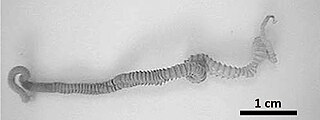
Gigantorhynchus is a genus of Acanthocephala that parasitize marsupials, anteaters, and possibly baboons by attaching themselves to the intestines using their hook-covered proboscis. Their life cycle includes an egg stage found in host feces, a cystacanth (larval) stage in an intermediate host such as termites, and an adult stage where cystacanths mature in the intestines of the host. This genus is characterized by a cylindrical proboscis with a crown of robust hooks at the apex followed by numerous small hooks on the rest of the proboscis, a long body with pseudosegmentation, filiform lemnisci, and ellipsoid testes. The largest known specimen is the female G. ortizi with a length of around 240 millimetres (9.4 in) and a width of 2 millimetres (0.08 in). Genetic analysis on one species of Gigantorhynchus places it with the related genus Mediorhynchus in the family Gigantorhynchidae. Six species in this genus are distributed across Central and South America and possibly Zimbabwe. Infestation by a Gigantorhynchus species may cause partial obstructions of the intestines, severe lesions of the intestinal wall, and may lead to death.
Dendronucleata is a genus of small parasitic spiny-headed worms. It is the only genus in the family Dendronucleatidae. This genus contains three species that are distributed globally, being collected in North America and Asia. The distinguishing features of this genus among Archiacanthocephalans is the presence of randomly distributed dendritically branched giant hypodermic nuclei. Dendronucleata parasitize freshwater fish and a salamander by attaching themselves in the intestines using their hook covered proboscis and adhesives secreted from cement glands.
Cucullanorhynchus is a monotypic genus of acanthocephalans. It contains a single species, Cucullanorhynchus constrictruncatus, which infests leopards in Vietnam.
Australiformis is a monotypic genus of acanthocephalans containing a single species, Australiformis semoni, that infests marsupials in Australia and New Guinea. Its body consists of a proboscis armed with hooks which it uses to pierce and hold the gut wall of its host, and a long trunk. This genus resembles species in the genus Moniliformis but is characterized by a lack of spiral muscles in the outer wall of the proboscis receptacle. The proboscis is armed with 12 rows of 13 to 15 hooks which are used to attach themselves to the small or large intestines of the host. The female worms range from 95 to 197 millimetres long, virtually all of which is the trunk, and 1.75 to 3.5 millimetres wide. There is pronounced sexual dimorphism in this species as females are around twice the size of the males whose trunks range from 46 to 80 millimetres long and 2 millimetres (0.079 in) wide. Infestation by A. semoni may cause debilitating inflammation of the stomach (gastritis) with granulomatous ulcers.
Atactorhynchus is a genus in Acanthocephala which contains two species, A. verecundus and A. duranguensis.
Eocollis is a genus in Acanthocephala.
Machadosentis is a monotypic genus of acanthocephalans containing a single species, Machadosentis travassosi, that infests animals.
Raosentis is a genus of Acanthocephala that parasitize the intestine of fish.
Triaspiron is a monotypic genus of acanthocephalans containing a single species, Triaspiron aphanii.
Caballerorhynchus is a monotypic genus of acanthocephalans containing a single species, Caballerorhynchus lamothei, that infests animals.
Pallisentis is a genus in Acanthocephala.
Wolffhugelia is a monotypic genus of acanthocephalans containing a single species, Wolffhugelia matercula, that infests animals.
Dispiron is a genus in Acanthocephala belonging to the family Neoechinorhynchidae.
Hexaspiron is a genus in Acanthocephala belonging to the family Neoechinorhynchidae.
Gorytocephalus is a genus in Acanthocephala belonging to the family Neoechinorhynchidae.
Octospiniferoides is a genus in Acanthocephala belonging to the family Neoechinorhynchidae.
Intraproboscis is a monotypic genus of acanthocephalans that infest African black-bellied pangolin in the Central African Republic. Its body consists of a proboscis armed with hooks which it uses to pierce and hold the gut wall of its host, and a long trunk. It contains a single species, Intraproboscis sanghae. This genus resembles species in the genus Mediorhynchus but is characterized by infesting a mammal instead of birds, and having a simple proboscis receptacle that is completely suspended within the proboscis, the passage of the retractor muscles through the receptacle into the body cavity posteriorly, absence of neck, presence of a parareceptacle structure, and a uterine vesicle. The proboscis is armed with 34–36 rows of 6 to 7 hooks anteriorly and 15–17 spinelike hooks posteriorly which are used to attach themselves to the intestines of the host. The female worms are up to 180 millimetres long, virtually all of which is the trunk, and 2 millimetres wide.
Acanthodelta is a genus of acanthocephalan.
Mayarhynchus is a monotypic genus of acanthocephalans containing a single species, Mayarhynchus karlae, that infests animals.
Paraechinorhynchus is a monotypic genus of acanthocephalans containing a single species, Paraechinorhynchus kalriai, that infests the rohu.

